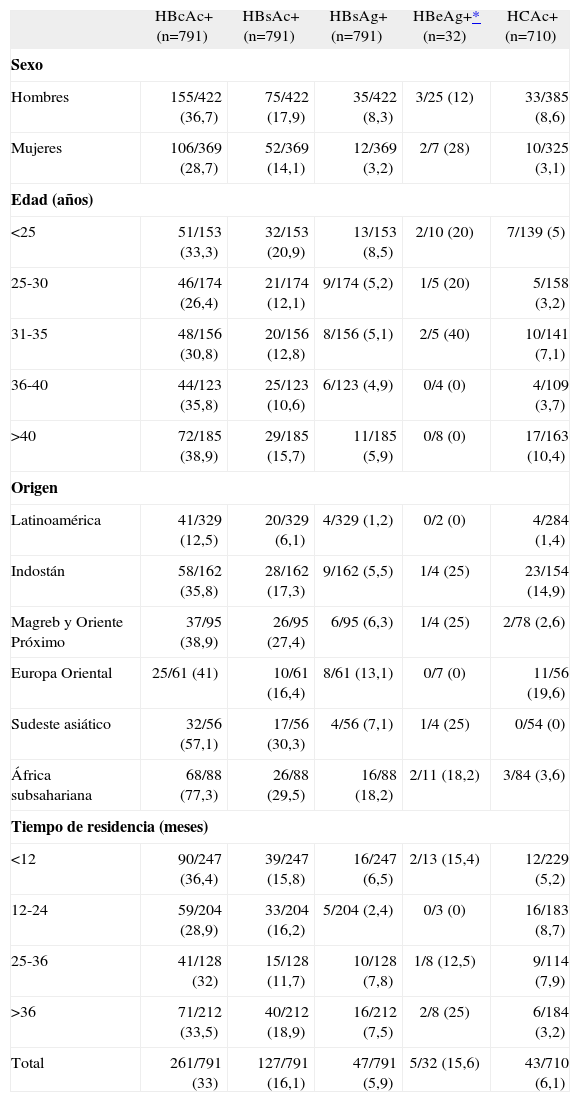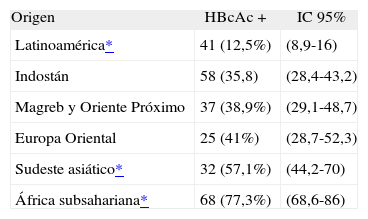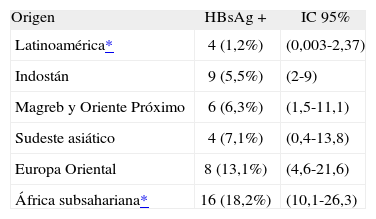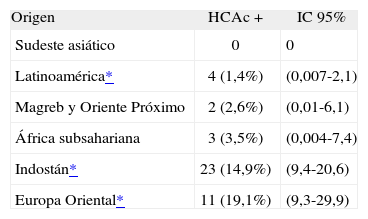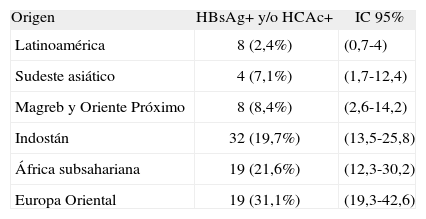La prevalencia de las hepatitis crónicas víricas en la Unión Europea variará debido a la recepción de inmigrantes procedentes de países con elevada endemia de infección crónica por virus de la hepatitis B (VHB) y C (VHC). La inclusión de su cribado en inmigrantes sanos es un tema debatido en los planos de factibilidad, ética y de coste-efectividad.
Los objetivos del estudio fueron: a) conocer la prevalencia de marcadores contra la hepatitis crónica y, b) determinar una estrategia costeefectiva de vacunación contra la hepatitis B.
Población y métodoEstudio observacional prospectivo y multicéntrico a nivel de Atención Primaria en Cataluña (España), definido sobre la población de inmigrantes sanos con menos de 5 años de residencia en la Unión Europea.
ResultadosSe estudiaron 791 individuos. Presentaron HBcAc+ 33% (intervalo de confianza [IC] 95% 29,6-36,1) y HBsAc+ 16,1% (IC 95% 11,4-20,8). Presentaron antígeno de superficie positivo (HBsAg+) 5,9% (IC 95% 3-8,7), de los cuales el antígeno soluble positivo (HBeAg+) 15,62% (IC 95% 5,3-32,8). La población subsahariana presentó la mayor prevalencia de HBcAc+ (77,3%) y de HBsAg+ (18,2%) y la latinoamericana, la menor (12,5% y 1,2%, respectivamente). La determinación serológica prevacunación se mostró coste-efectiva a partir de una seroprevalencia HBcAc+ >48,72%, valor sólo superado por el IC de la población subsahariana (IC 95% 68,6-86). Presentaron anticuerpos contra el virus de la hepatitis C (HCAc+) 6,1% (IC 95% 4,3-7,8), especialmente el colectivo de Europa Oriental (19,6%) e Indostán (14,9%). La comunidad con menor prevalencia fue asimismo la latinoamericana (1,4%).
DiscusiónLa prevalencia de marcadores de hepatitis crónica vírica se sitúa en un nivel intermedio entre las descritas en los ámbitos de Atención Primaria y especializada. La población inmigrante en su conjunto muestra prevalencias de marcadores HBsAg+ y HCAc+ que hacen recomendable su cribado excepto para el colectivo latinoamericano. La determinación serológica previa a la vacunación sólo es coste-efectiva en el colectivo subsahariano.
The prevalence of chronic viral hepatitis in the European Union (EU) will vary because of the immigrants coming from countries having an elevated with a higher endemicity of hepatitis B (HBV) and C virus (HCV); Serologic screening in healthy immigrants is a subject that has been discussed in the areas of feasibility; ethics and cost-effectiveness; The main study aims were: a) to know the prevalence of chronic hepatitis markers and; b) to determine the best cost-effectiveness strategy of vaccination against hepatitis B
Population and methodAn observational, perspective and multicenter study was performed on the Primary Care level in Catalonia (Spain) among healthy immigrants who had lived in the EU for less than 5 years.
ResultsData from 791 individuals were analyzed. They presented anti-HBc+ 33% (95% CI 29.6 -36.1), and anti-HBs+ 16.1% (95% CI 11.4 -20.8). HBsAg+ was 5.9% (95% CI 3-8.7), of those were HBeAg+ 15.62% (95% CI 5.3-32.8). The sub-Saharan group presented the higher prevalence of anti-HBc+(77.3%) and HBsAg+ (18.2%), whereas the Latin American-origin population displayed the lowest one (12.5% and 1.2%, respectively). Determination of antibodies prior to vaccination was found as cost-effective from a seroprevalence anti-HBc+> 48.72%; only overcome by the CI of sub-Saharan population (95% CI 5.3-32.8). The prevalence of anti-HC+ was 6.1% (95% CI 4.3-7.8), especially high among the Eastern European (19.6%) and Indostanic (14.9%) population. The Latin American group had the lowest prevalence (1.4%).
ConclusionsThe prevalence of chronic viral hepatitis markers is found to be at an intermediate level between those described by primary and specialized care levels. The prevalences of HBsAg+and anti-HC+ in the immigrant population, on the whole, are such that it is advisable to screening for them, with the exception of the Latin American community. Previous serologic determination of markers is only cost-effective among the sub-Saharan community.
Article
Diríjase desde aquí a la web de la >>>FESEMI<<< e inicie sesión mediante el formulario que se encuentra en la barra superior, pulsando sobre el candado.

Una vez autentificado, en la misma web de FESEMI, en el menú superior, elija la opción deseada.

>>>FESEMI<<<



